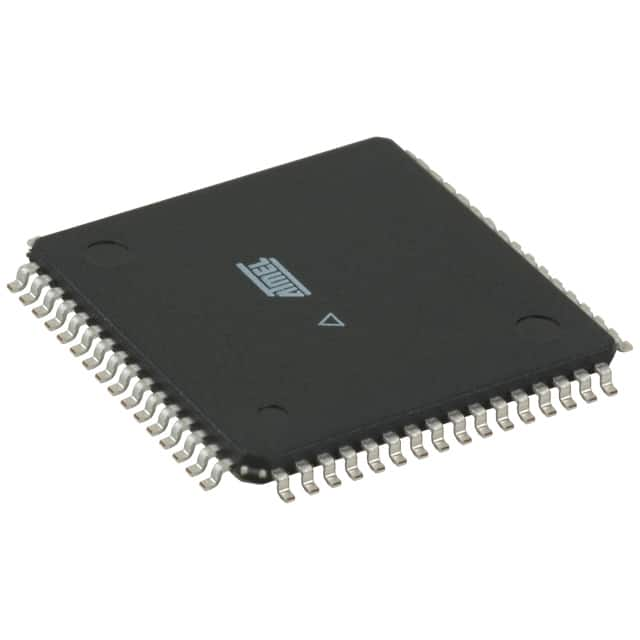Viz Specifikace pro podrobnosti o produktu.

ATMEGA103-6AI
Product Overview
Category
ATMEGA103-6AI belongs to the category of microcontrollers.
Use
It is primarily used for embedded systems and various electronic applications.
Characteristics
- High-performance microcontroller with advanced features
- Low power consumption
- Wide operating voltage range
- Large program memory capacity
- Multiple communication interfaces
- Enhanced security features
Package
ATMEGA103-6AI is available in a compact and durable package, suitable for surface mount technology (SMT) applications.
Essence
The essence of ATMEGA103-6AI lies in its ability to provide efficient and reliable control for electronic devices and systems.
Packaging/Quantity
ATMEGA103-6AI is typically packaged in reels or tubes, with a quantity of 250 units per reel/tube.
Specifications
- Microcontroller Architecture: AVR
- CPU Speed: 16 MHz
- Flash Memory: 128 KB
- RAM: 4 KB
- EEPROM: 4 KB
- Operating Voltage: 2.7V - 5.5V
- Digital I/O Pins: 53
- Analog Input Channels: 8
- Communication Interfaces: UART, SPI, I2C
- Timers/Counters: 6
- PWM Channels: 6
- ADC Resolution: 10-bit
- Operating Temperature Range: -40°C to +85°C
Detailed Pin Configuration
The ATMEGA103-6AI microcontroller has a total of 64 pins, which are assigned different functions based on their configuration. The pinout diagram and detailed pin configuration can be found in the product datasheet.
Functional Features
- High-Speed Processing: The 16 MHz CPU speed allows for fast execution of instructions, enabling real-time control and responsiveness.
- Extensive Memory: The large program memory capacity and additional EEPROM provide ample storage for code and data.
- Versatile I/O: With 53 digital I/O pins and 8 analog input channels, the microcontroller can interface with a wide range of sensors and actuators.
- Communication Interfaces: The UART, SPI, and I2C interfaces facilitate seamless communication with other devices or modules.
- Timers/Counters and PWM: The multiple timers/counters and PWM channels enable precise timing control and generation of analog signals.
- Enhanced Security: Built-in security features protect against unauthorized access and ensure the integrity of the system.
Advantages and Disadvantages
Advantages
- High-performance capabilities
- Low power consumption
- Wide operating voltage range allows for flexibility in power supply options
- Ample program memory and storage capacity
- Multiple communication interfaces for versatile connectivity
- Enhanced security features for improved system integrity
Disadvantages
- Relatively higher cost compared to lower-end microcontrollers
- Steeper learning curve due to advanced features and functionalities
- Limited availability of alternative models with similar specifications
Working Principles
ATMEGA103-6AI operates based on the AVR architecture, utilizing a combination of hardware and software to execute instructions and control various peripherals. It follows a Von Neumann architecture, where program instructions and data are stored in separate memories. The microcontroller fetches instructions from the program memory, processes them using the CPU, and interacts with external devices through its I/O pins and communication interfaces.
Detailed Application Field Plans
ATMEGA103-6AI finds applications in a wide range of fields, including but not limited to: 1. Industrial Automation: Control systems, robotics, and process monitoring. 2. Consumer Electronics: Home appliances, gaming consoles, and wearable devices. 3. Automotive: Engine management, dashboard controls, and safety systems. 4. Internet of Things (IoT): Smart home devices, environmental monitoring, and data logging. 5. Medical Devices: Patient monitoring, diagnostic equipment, and implantable devices.
Detailed and Complete Alternative Models
While ATMEGA103-6AI is a highly capable microcontroller, there are alternative models available with similar specifications. Some notable alternatives include: 1. ATMEGA128A-PU 2. PIC18F4550 3. STM32F407VG
These alternative models offer comparable features and can be considered based on specific project requirements and compatibility with existing systems.
In conclusion, ATMEGA103-6AI is a high-performance microcontroller with advanced features, suitable for a wide range of applications. Its efficient processing, extensive memory, versatile I/O, and enhanced security make it a reliable choice for embedded systems and electronic projects.
Seznam 10 běžných otázek a odpovědí souvisejících s aplikací ATMEGA103-6AI v technických řešeních
Sure! Here are 10 common questions and answers related to the application of ATMEGA103-6AI in technical solutions:
Q: What is ATMEGA103-6AI? A: ATMEGA103-6AI is a microcontroller from the AVR family, manufactured by Microchip Technology. It offers a wide range of features and is commonly used in various technical solutions.
Q: What are the key features of ATMEGA103-6AI? A: Some key features of ATMEGA103-6AI include a 8-bit RISC architecture, 32KB of flash memory, 1KB of EEPROM, 2KB of SRAM, multiple communication interfaces, and various peripherals.
Q: What applications can ATMEGA103-6AI be used for? A: ATMEGA103-6AI can be used in a wide range of applications such as industrial automation, robotics, consumer electronics, automotive systems, and IoT devices.
Q: How can I program ATMEGA103-6AI? A: ATMEGA103-6AI can be programmed using various programming languages like C or assembly language. You can use development tools like Atmel Studio or Arduino IDE to write and upload your code to the microcontroller.
Q: What voltage does ATMEGA103-6AI operate at? A: ATMEGA103-6AI operates at a voltage range of 2.7V to 5.5V.
Q: Can I interface ATMEGA103-6AI with other components or sensors? A: Yes, ATMEGA103-6AI has multiple GPIO pins and supports various communication protocols like SPI, I2C, and UART, allowing you to easily interface it with other components or sensors.
Q: Does ATMEGA103-6AI have built-in analog-to-digital converters (ADC)? A: Yes, ATMEGA103-6AI has an 8-channel, 10-bit ADC that can be used to convert analog signals into digital values.
Q: Can I use ATMEGA103-6AI for real-time applications? A: Yes, ATMEGA103-6AI has a real-time counter (RTC) and supports external interrupts, making it suitable for real-time applications.
Q: What is the maximum clock frequency of ATMEGA103-6AI? A: The maximum clock frequency of ATMEGA103-6AI is 16 MHz.
Q: Where can I find more information about ATMEGA103-6AI? A: You can refer to the datasheet and documentation provided by Microchip Technology for detailed information about ATMEGA103-6AI, including its pinout, electrical characteristics, and programming guidelines.
Please note that the specific details and answers may vary depending on the version or revision of the ATMEGA103-6AI microcontroller.

